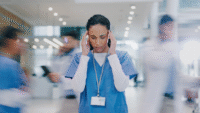Things to know before you make the leap
Takeaways:
- Nurses are perfectly positioned to engage in medical device development.
- The pathway to medical device development includes intellectual property protection, developing partnerships and acquiring funding, conducting market research, and creating a manufacturing plan.
- Partnerships are key to successful device development.
Historically, device development and entrepreneurship often have fallen to physicians, but now more nurses who work in clinical environments are participating and leading in this area. With my research partner, I developed an oral suction indwelling sponge device for intubated patients to prevent aspiration and ventilator-acquired pneumonia. During development, we found that the device could decrease sputum-based secretions that frequently saturate central venous line sites, which could reduce hospital-acquired or central venous line site infections. The product is beginning human clinical trials.
With an innovative mindset, perseverance, and an understanding of the pathways to development, nurses can create devices that improve patient care and safety. (See History of nurse innovators.) However, the lengthy process to move from idea to market requires dedication and commitment.
History of nurse innovators
Nurses have a long history as innovators and inventors. According to Davis and Glasgow, from 1865 to 2003, 42 nurses invented 94 devices.
- Bessie Blount Griffin, a nurse and physical therapist, developed a feeding tube for paralyzed World War II veterans.
- Anita Dorr developed the crash cart in response to the slow response times attributed to gathering necessary supplies to treat critically ill patients.
- Neomi Bennett, a nurse in the United Kingdom, developed the Neo-slip device for ease of donning deep vein thrombosis socks.
- Terri Barton-Salina and Gail Barton-Hay developed color-coded I.V. lines for easy distinction between I.V. solutions.
Other nurse-scientists and nurse-engineers developed these devices:
- Bili-Bonnet is a latex-free compression net bonnet that holds eye guards in place to reduce ultraviolet light exposure during jaundice treatment of neonates.
- Aqua-Box, a wall-mounted canister, is used to treat contaminated fluids with approved disinfectants before disposal.
- NeoNur measures the sucking, breathing, and swallowing that can indicate developmental issues in premature infants.
Patenting and perseverance
Anyone who’s traveled the product-to-market trail will tell you it’s not easy. It takes years of determination and belief in a product to see it through the necessary steps of development, intellectual property and patent protection, licensure, and marketing.
Two primary types of device patents exist. The first, a design patent, protects the appearance or design of the product. Design patents typically take about 2 years to receive. The second and stronger patent is the utility patent, which protects a product’s use and function. Utility patents can take 5 years or longer to acquire. According to a 2015 article by Quinn and an interview with patent attorney Paul Rauch, legal costs for the U.S. patent process vary greatly depending on the complexity of the invention, ranging from $6,000 to more than $20,000. Based on my experience, these costs may be low.
Keep in mind that a U.S. patent doesn’t protect a product from being reproduced by a company in another country. Acquiring international patents add considerably to the costs. Expenses also can increase when other similar products already exist. In addition, the more communication required with a patent attorney, the higher the costs.
Partnering to share costs may help prevent patent abandonment when funds run low and a significant sum of money already has been invested. According to Belderbos and colleagues, partnering and co-patenting with a university is associated with higher product valuation.
Pathway to market
A basic understanding of the patent process—including concept development, intellectual property protection, partnerships and funding, market research, and manufacturing—can help you navigate it to your advantage.
Step 1: Concept development
After you’ve formed an idea for a device, gather information about similar products for future reference. An idea isn’t patentable, so you must develop the details to the point where it becomes an invention that can be patented. Document the details and specifics of the product as thoroughly as possible to aid discussions with attorneys, investors, market researchers, and partners.
Prototype (preliminary model) development of your device can begin when you initiate the idea or later in the patenting phases. I chose to have a prototype before submitting the design patent and a working prototype (a model that performs the function for which the device is designed) when I applied for the utility patent. I found it easier to explain the device and its purpose to partners and consultants if they had the prototype in hand.
Step 2: Intellectual property protection
Your idea is intellectual property that should be protected. Avoid sharing it with anyone (family, friends, attorneys) without having them sign a bilateral confidentiality agreement (you can find templates online). Consider writing a detailed description of your invention with drawings and graphics and mailing it to yourself. When it arrives, put it in a secure location, unopened, as proof of the conception date.
Several online, self-patent sources are available for a range of prices, but an experienced patent attorney can help guide you through the process and provide you with cost estimates upfront. (See Ask the right questions.)
Ask the right questions
Before engaging a patent attorney, ask these questions:
- Will you provide an estimate of costs that covers everything from the initial patent application to U.S. and international patent awards?
- What’s your patent application success rate?
- Can you provide a list of references for clients who’ve received patents?
- How will you bill for your services? Will it be by 15-minute blocks, a flat rate for a provisional patent application, or a combination?
- What specific medical devices or products have you patented?
Don’t present your idea in a public forum (such as a poster or podium presentation) until after the patent application has been processed and completed. If you make a presentation too early in the process, your idea is fair game for someone else to develop. Companies are on the lookout for new products, and the one thing they may lack is a connection to bedside caregivers who have innovative ideas. The nursing perspective may be just what’s needed to tweak a concept a company is developing. If you’re in doubt about whether to present to a group of investors or academicians, consult with your patent attorney first, even before signing a confidentiality agreement with the group.
Step 3: Partnerships and funding
Funding and partnerships can be acquired through universities, venture capital firms, and angel investors.
Many universities have technology development or technology transfer departments that help develop products or ideas to the patenting and manufacturing phase. For a share in either ownership or royalties, the university offers resources that are difficult for an individual to access. Technology transfer departments support entrepreneurs with prototype development, partner acquisition, and funding to develop a product or build a startup business.
Venture capital firms are another option, but you may have to give up a large percentage of the profits and allow the firm to develop the product.
Angel investors usually are individuals who invest in the entrepreneur and the product and share in ownership.
Step 4: Market research
During the patenting process, your attorney will do some market research, but as your product develops more fully, market research by a specialist firm may be required to determine device value for sales in the marketplace and for potential investors. Some market research firms specialize (for example, in pharmaceuticals, medical devices, software, or computer technology), whereas others are large and diverse. Consider working with a full-service market research firm, which will design surveys specific to your product and conduct interviews with industry leaders and end users. These surveys and interviews will focus on device improvement, buy-in, acceptance, feasibility, and potential concerns. Other firms may only prepare demographics of competitive products.
Step 5: Manufacturing
Several options exist for medical device manufacturing. You can contract with a manufacturer to produce your product and package it, use a technology incubator that allows venture capital investors to form the business and manage manufacturing, or start your own manufacturing company. State and federal grants are available for startup businesses. These programs frequently offer incentives to manufacturing companies that will bring jobs to an area.
No matter which option you choose, keep in mind that all medical devices must comply with Food and Drug Administration and other regulatory agency guidelines.
A road to success
Many nurse entrepreneurs don’t have the immediate financial backing necessary for the full marathon required to develop an idea, continue patent work, and see the product to market. Alliances and partnerships can help pave the way for success, but they must be vetted and thoughtfully entered into. Your knowledge of the process and support from trusted sources can help pave your road to success.
Editor’s note: Access innovation resources that can help you develop your medical device idea at nursingworld.org/practice-policy/innovation/education.
Nina McLain-Calkins is an administrator in the nurse anesthesia program at The University of Southern Mississippi in Hattiesburg.
References
AUTM. What is tech transfer, anyway? autm.net/about-tech-transfer/what-is-tech-transfer
Belderbos R, Cassiman B, Faems D, Leten B, Van Looy B. Co-ownership of intellectual property: Exploring the value-appropriation and value-creation implications of co-patenting with different partners. Res Policy. 2014;43(5):841-52.
Communications for Research. The 5 kinds of market research firms: Which is right for you? cfrinc.net/cfrblog/5-kinds-of-market-research-firms
Cosier S. 8 medical inventions created by nurses. Mental Floss. May 2, 2017. mentalfloss.com/article/500467/8-medical-inventions-created-nurses
Davis CR, Glasgow MES. Nurse-scientists and nurse-engineers. Am Nurse Today. 2017;12(11):50-1.
Hughes F. Nurses at the forefront of innovation. Int Nurs Rev. 2006;53(2):94-101.
Johnson VY, Walsh EG. Nurses making a difference: The process of technology transfer. J Neurosci Nurs. 2005;37(5):289-92.
Kauffman Entrepreneurs. Angel investors and venture capitalists. August 19, 2016. entrepreneurship.org/learning-paths/financing-your-venture-angel-investment/angel-investors-and-venture-capitalists
Kramer DB, Xu S, Kesselheim AS. How does medical device regulation perform in the United States and the European Union? A systematic review. PLoS Med. 2012;9(7):e1001276.
Organisation for Economic Co-operation and Development. Innovation. oecd.org/innovation
Powers J. The short and long answers on patent applications. Best Lawyers. August 8, 2018. bestlawyers.com/article/how-long-does-it-take-to-obtain-a-patent/2065
Quinn G. Moving from idea to patent. When do you have an invention? IPWatchdog. November 23, 2018. ipwatchdog.com/2018/11/23/idea-patent-invention/id=103526
Quinn G. The cost of obtaining a patent in the US. IPWatchdog. April 4, 2015. ipwatchdog.com/2015/04/04/the-cost-of-obtaining-a-patent-in-the-us/id=56485/
Spōk. 6 healthcare devices you may not know were created by nurses. May 8, 2018. spok.com/general-healthcare/6-healthcare-innovations-you-may-not-know-were-created-nurses
U.S. Small Business Administration. Grants. sba.gov/funding-programs/grants


















